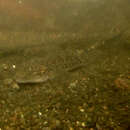pms
nòm ant ël fil


Awaous stamineus, commonly known as ‘O‘opu nakea, is a species of goby native to the Hawaiian Islands.[1] It has been previously considered a synonym of Awaous guamensis but recent work based upon morphological and genetic differences has recognized Hawaiian populations as being distinct.[2] Consequently, Hawaiian Awaous are now recognized as a valid, distinct species.[1][3]
‘O‘opu nakea are omnivores. Analyses of their gut volume have shown to consist 84% of filamentous algae and the other 16% of chironomids (non-biting midges).[4] ‘O‘opu nakea are about 14 inches long and have white streaks with speckles and a dark olive color.[5] They lay eggs downstream where the males and females guard the nest. The males make the nest and attract the females who then lay one clutch a year.[6]
Predators of this species include various birds, including the ‘auku‘u (black-crowned night heron), and other fishes, including āholehole (dark-margined flagtail), ulua (trevallies), moi (Pacific threadfin), and kākü (great barracuda).[7]
‘O‘opu nakea are found in slow-moving waters especially on Kaua‘i during their annual spawning run to the stream mouth.[4] ‘O‘opu nakea swim-up stream between 10 and 200 feet in strong currents.[8]
They are eaten raw or cooked. The usual way to prepare them is by salting them for 12 hours,[5] then wrapping them in ti leaves and placing them over hot coals.[5]
Awaous stamineus, commonly known as ‘O‘opu nakea, is a species of goby native to the Hawaiian Islands. It has been previously considered a synonym of Awaous guamensis but recent work based upon morphological and genetic differences has recognized Hawaiian populations as being distinct. Consequently, Hawaiian Awaous are now recognized as a valid, distinct species.